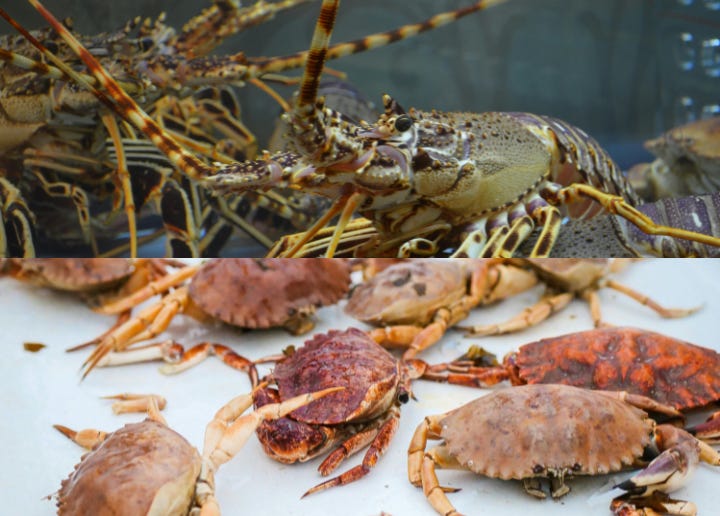Crabs & Lobsters Do Feel Pain: Groundbreaking Research Calls for Greater Animal Welfare Protections
Animal Rights
A groundbreaking study conducted by researchers at the University of Gothenburg, Sweden, has confirmed that crabs experience pain, challenging long-standing assumptions about crustacean sentience. This research provides compelling evidence that the responses of crabs to harmful stimuli are not merely reflexive but involve pain processing in their brains. Published in the journal Biology, the findings carry significant implications for the humane treatment of crabs and other crustaceans.
‘‘New research confirms crabs feel pain, with brain signals proving their responses are not reflexes. Despite mounting evidence, crustaceans remain unprotected under many laws and are routinely boiled alive. Ethical alternatives like plant-based seafood can help reduce cruelty and promote compassionate choices.’’
What the Research Revealed
Previous studies suggested that crustaceans could feel pain based on behavioral observations. However, this new study is the first to measure pain responses in crabs using EEG-style methods. The researchers observed and recorded brain activity in shore crabs when exposed to chemical and mechanical stimulation, detecting pain signals being sent to their brains.
Lead study author Eleftherios Kasiouras explained the importance of these findings, emphasizing that pain systems are essential for all animals to avoid danger. "I don’t think we need to test all species of crustaceans, as they have a similar structure and therefore similar nervous systems,” Kasiouras noted. He added that it is reasonable to assume that other crustaceans, such as lobsters, shrimp, and crayfish, also experience pain. This assertion underscores the need for ethical considerations across the seafood industry.
The Scale of the Issue
The seafood industry processes up to 580 billion farmed crustaceans annually, including crabs, lobsters, prawns, and shrimp. These animals are often killed in ways that many argue are cruel, such as boiling them alive, particularly in regions where animal welfare laws do not include crustaceans. Even within the European Union, there is no specific legislation protecting these animals, leaving them vulnerable to inhumane practices.
Despite growing evidence of crustacean sentience, legislative change has been slow. In 2021, the UK formally recognized crustaceans and cephalopods as sentient beings under its Animal Sentience Bill. While this marked a significant step forward, it has not translated into widespread changes in how these animals are treated. Many crabs, lobsters, and other shellfish are still subjected to painful deaths.
Ethical Concerns in Research
While the findings add weight to the argument for greater protection of crustaceans, the research itself raises ethical questions. To establish pain response, the study required exposing crabs to painful stimuli and recording the results, a process that some critics argue perpetuates harm. Advocates for animal welfare stress that the existing body of research already provides sufficient evidence to justify protecting these animals, making further painful experiments unnecessary.
The Case for Change
The implications of this study go beyond academic interest. It bolsters the position of animal rights advocates who argue that current farming and fishing practices for crustaceans are inherently cruel. Many believe that humane alternatives, such as abstaining from eating these animals altogether, are the only ethical solution. As Eleftherios Kasiouras pointed out, the pain systems observed in crabs likely extend to other crustaceans, making the argument for systemic change even stronger.
Plant-based seafood alternatives offer a promising solution for those who wish to avoid contributing to the suffering of crustaceans while still enjoying familiar flavors and textures. These products have gained popularity in recent years, providing a cruelty-free option that aligns with ethical values.
Moving Forward
The recognition of crustaceans as sentient beings capable of feeling pain is a significant milestone, but legislative and societal changes are needed to ensure their protection. While some countries have made progress, such as the UK’s recognition of crustacean sentience, enforcement and practical changes remain limited. Without action, the findings of studies like this risk being little more than a moral footnote.
Advocates for animal welfare argue that the best way to prevent cruelty to crustaceans is to stop consuming them. By choosing plant-based alternatives, individuals can contribute to a shift away from practices that cause harm to billions of sentient beings. With continued research and public awareness, there is hope for a future where all animals, including crabs and lobsters, are treated with the respect and compassion they deserve.
This study serves as a reminder that ethical progress is often slow but necessary. As our understanding of animal sentience grows, so too should our commitment to making choices that align with compassion and justice for all living beings.
Sources:
University of Gothenburg research published in Biology: Biology Journal
UK Animal Sentience Bill information: UK Government Legislation
Coverage on crustacean sentience and animal welfare: Plant Based News
Alternative seafood market developments: Read more on Science Direct
Get my new booklet ‘‘25 Vegan Myths Debunked!’’
This concise guide is invaluable for anyone curious about veganism, offering evidence-based insights and practical guidance to navigate vegan living confidently. All proceeds benefit the promotion of animal rights worldwide!Visit Our Amazon Store!
Notice: As an Amazon Associate, we earn a commission from qualifying purchases that help promote animal rights worldwide!






Also shellfish are high in cholesterol.
Shellfish Cholesterol Content Per Serving:
Shrimp 220 mg
Crab 102 mg
Lobster 92 mg
Clams 67 mg
Oysters 100 mg
Mussels 57 mg
Scallops 41 mg
Octopus 98 mg
Squid 237 mg
Snail 51 mg
The 2020-2025 Dietary Guidelines for Americans recommend dietary cholesterol amounts between 100 mg and 300 mg per day.